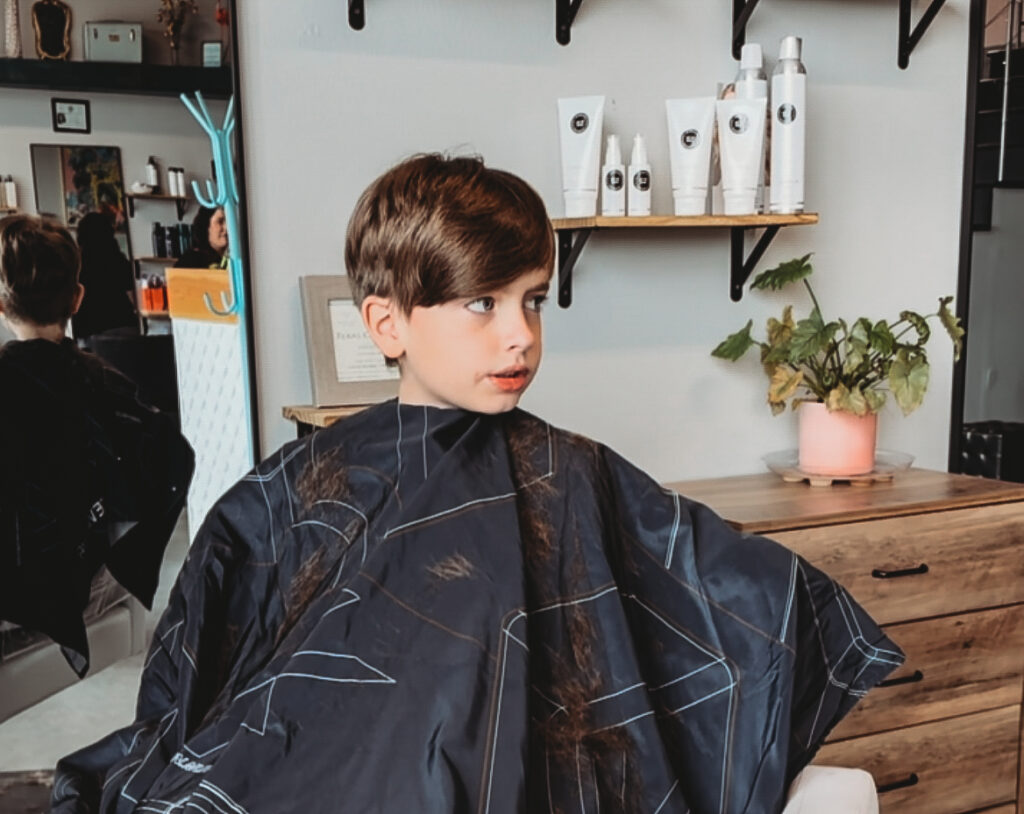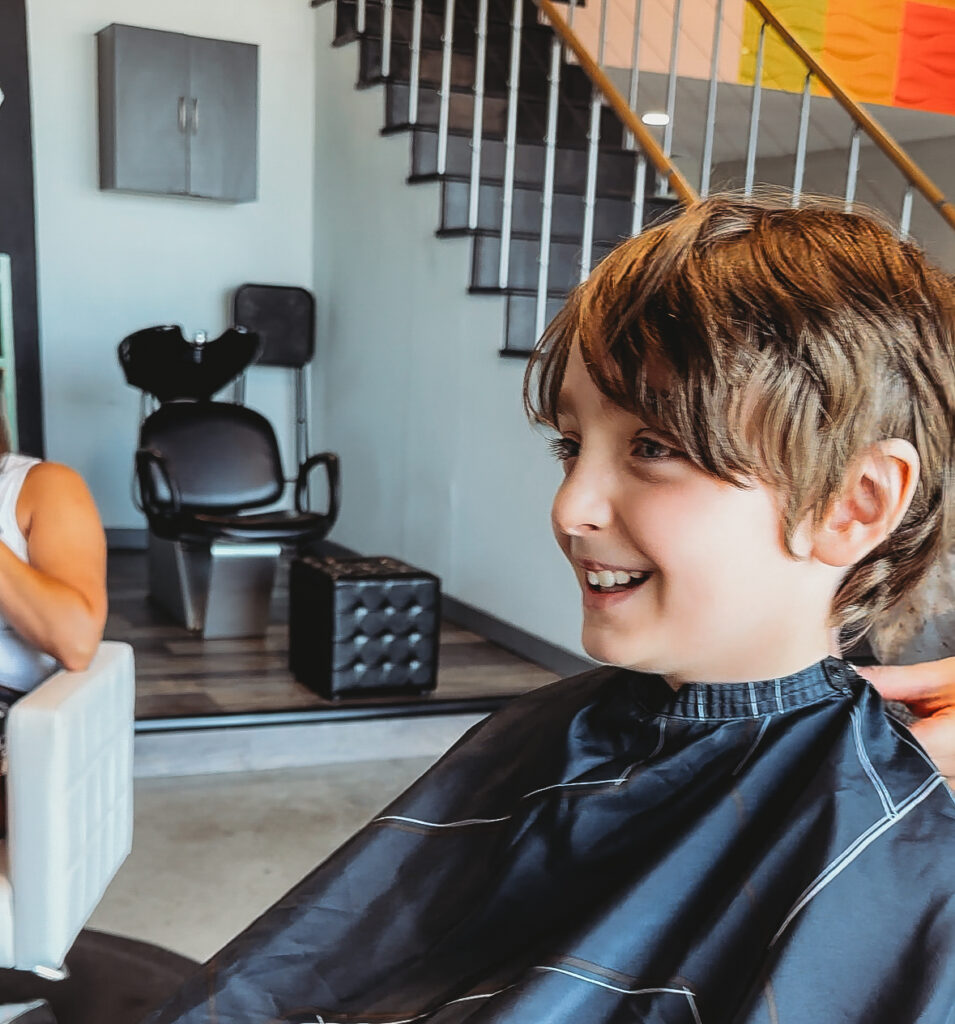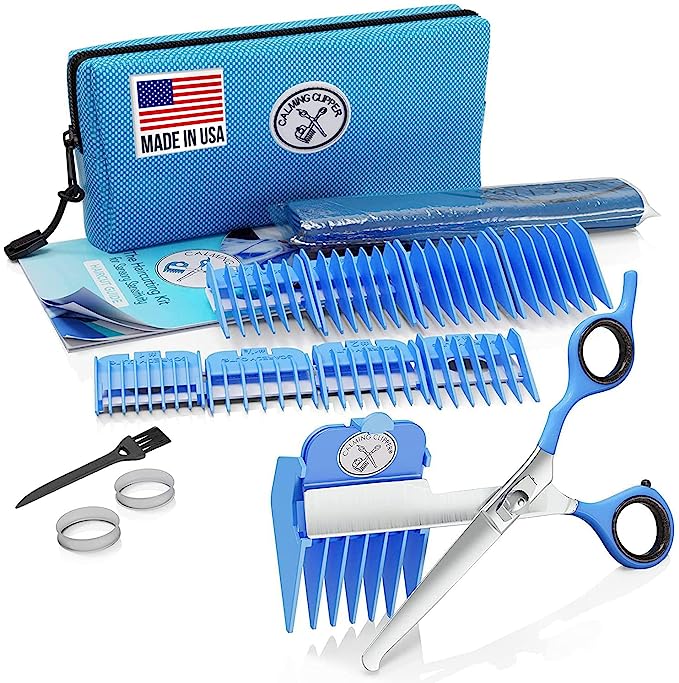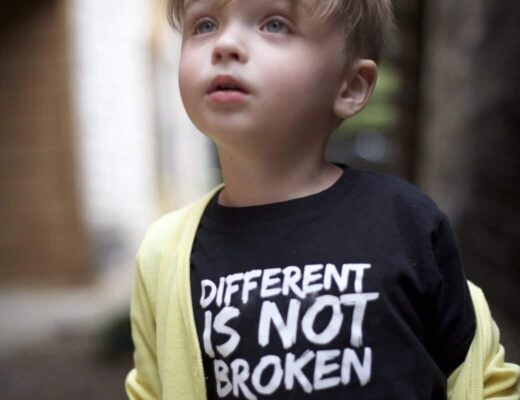
Autism and haircuts often do not mesh well together. As an autistic mother raising two children, each on opposite ends of the autism spectrum, I have had to get creative to get my boys’ hair cut. My oldest son, Charlie, 10, is diagnosed with Level 3, severe autism, while my younger son, Jude, 8, has Level 1 autism. One particular challenge both of them faced was difficulty with haircuts. What worked for Charlie did not work for Jude, and vice versa. In this article, I will share the strategies I used to help each of them overcome their fears and make haircuts a more tolerable experience.
Autism and haircuts: How we made the process less traumatizing for our son with severe autism
Haircut Task Analysis Using ABA Therapy
Applied Behavior Analysis (ABA) Therapy played a huge role in helping Charlie tolerate haircuts. If you’re not familiar with ABA, you can read more about it here. We used a step-by-step approach to help him with haircutting, breaking down the haircutting process into manageable stages. Each step was practiced individually until Charlie felt comfortable before moving on to the next one. Don’t move to the next step until your child has mastered the previous.
The Steps We Followed:
- Sitting in a chair near haircutting materials (scissors, buzzers, hair dryer)
- Hearing the phrase “it’s time for a haircut” in the presence of haircutting materials
- Wearing a barber’s cape
- Allowing someone to comb his hair
- Remaining calm upon seeing scissors near his hair
- Tolerating the sound of the buzzer being turned on near his hair
- Tolerating the touch of the buzzer and/or scissors on his skin
- Tolerating the use of a hairdryer

Implementing Positive Reinforcement:
At first, Charlie couldn’t tolerate Step 1, which is to sit near haircutting materials. We kept trying every day, for short periods of time to not overwhelm him until he was fully comfortable with it. And so on. Positive reinforcement is key here; praise your child when they’re doing a good job. I’m big on rewards. Charlie loves treats, which works for us, but this must be personalized to your child.
Witnessing Charlie’s progress, like allowing his RBT to comb his hair without screaming, was heartwarming. Initially, I doubted it was even possible. Patience and breaking down the process into achievable steps were key factors in our success. Remember, every child with autism is unique, and you, as a parent, know your child best.
Watch Charlie get a haircut in a salon at 10 years old
How I helped my son with Level 1 Autism, overcome his fear of haircuts
Jude’s experience with autism is much different from Charlie’s. Unlike his nonverbal brother, Jude is VERY verbal, which allowed us to identify and address specific concerns related to haircuts. After asking the right questions, Jude was able to articulate his struggles related to autism and haircuts, which included:
- Fear of getting hurt
- Negative sensory experiences of hair being touched
- Itchiness caused by hair falling on his skin
- Feeling of being choked by the barber’s cape around his neck
- Anxious feelings associated with the noise and sensation of the buzzer
- General anxiety surrounding the entire haircut experience
Strategies We Implemented:
- Offering a Reward System: We allowed Jude to choose a reward to look forward to after the haircut, usually a toy or treat. This motivated him during the process.
- Providing a Makeup Brush: To address itchiness, we gave Jude a makeup brush to brush off the hair from his body, reducing discomfort and sensory irritation.
- Selecting a Barber Cape: To prevent the feeling of being strangled, we got a barber cape that did not fully cover his neck, alleviating his discomfort.
- Using Scissors Only: Since the noise of the buzzer was bothersome to Jude, we initially did haircuts using scissors alone, to avoid any sensory distress caused by the buzzer.
- Taking Breaks and Allowing Distractions: We allowed Jude to take as many breaks as needed during the haircut and let him watch TV to provide a positive distraction from any anxiety or discomfort.
Note: Haircuts rarely took less than 3 hours from start to finish… Initially, we did haircuts at home to gradually build his confidence before we considered transitioning to a professional hair salon. When you’re ready to move on to a salon haircut, find a hairdresser who has the patience and understanding required to help autistic children through the haircutting process. Ask in local Facebook groups.
My favorite tip:
For verbal autistic children, consider having them record a video for their future self after a successful haircut. Show them the video before each haircut to remind them of their previous achievements and reassure them that it won’t be as challenging as expected. I have a video of Jude saying: “I just had a haircut and it wasn’t so bad after all”. I show him before each haircut to remind him that he’s done it before and it’s never as bad as he expects it.
Additional Tips and Resources to help with autism and haircuts
This section contains affiliate links, at no cost to you. Thank you for your support!
While these didn’t work for us, several tools and strategies have been successful for other autistic children, including:
- Clear barber capes that allow the child to use an iPad or tablet.
- Calming clippers are designed to reduce noise and discomfort.
- Sensory-friendly hours at hair salons
- Social stories and books that break down the steps of getting a haircut
What works for one autistic child won’t work for the other but I hope you find a strategy/tip in this article that will help your autistic child not feel so distressed during haircuts.
Any autism and haircuts tips? Drop them in the comments!





3 Comments
Kathleen Blaison-Dumoulin
2023-07-16 at 6:01 PMThank you for these advice
Love you ❤️
Valerie Herskowitz
2023-07-16 at 11:57 PMGreat article! I’ll just add that the good news is that it gets better when they get older. But some ideas for going to the barbershop:
1. Social stories
2. Calming music while getting a haircut
3. Going to the barber during their slow times
4. Giving big tips to the barber so they won’t feel pressured to work quickly.
5. Using the same barber each time.
6. Not using clippers but shears. (I realized this could be done when I ended up doing haircuts myself all throughout the pandemic)
Primos Barbershop
2024-07-17 at 6:09 PMWow, thanks for sharing your experiences and strategies with haircuts for autistic children. As a barbershop owner who offers kids’ haircuts, I can definitely relate to the challenges you describe.
I’ve found that patience, flexibility, and open communication are key. We try to create a calm and welcoming environment, and we’re always happy to adjust our approach to meet the individual needs of each child.
I love the idea of recording a video for verbal children to watch before their next haircut! That’s a great way to help them feel more prepared and less anxious.
We’ve also had success with offering sensory toys and fidgets, letting kids watch videos or listen to music during their haircut, and taking breaks as needed. It’s all about finding what works for each individual child.
Thanks again for sharing your insights. It’s always helpful to hear from other parents and professionals who are navigating the unique challenges of autism.